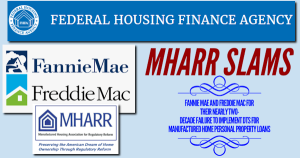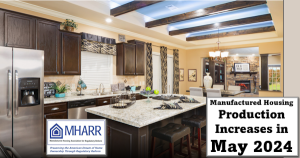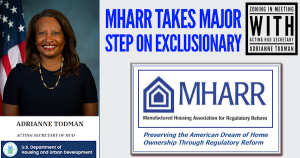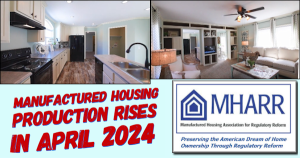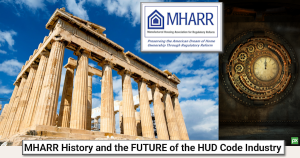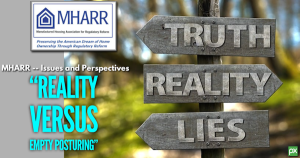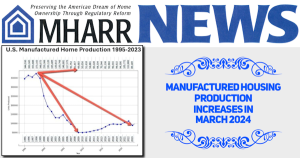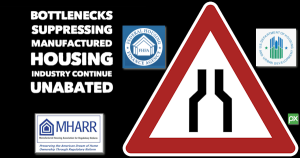Manufactured Housing Association for Regulatory Reform November 20, 2020 Washington Update — An Exclusive Report and Analysis
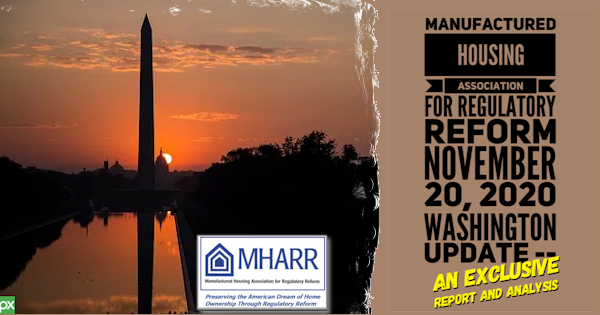
REPORT AND ANALYSIS
IN THIS REPORT: NOVEMBER 20, 2020
- MHARR BOARD SHARPENS FOCUS ON POST-PRODUCTION ISSUES
- FHFA DTS “COMPLIANCE” REPORT SHOWS CONTINUING DECEPTION
- HUD WASTES FOUR YEARS WITHOUT MAJOR PROGRAM REFORMS
- PROPOSED FHFA “NEW PRODUCTS” RULE MORE OF THE SAME FOR DTS
- AFTER TWENTY YEARS HUD UPDATES RULE ON STATE PAYMENTS
- MHCC SUBCOMMITTEES CONSIDER NEW PROPOSALS
INDUSTRY’S CONTINUING POST-PRODUCTION FAILURES CAUSE FOR ALARM
With the state of the industry’s critical post-production issues (i.e., consumer financing and discriminatory zoning and placement) in a free-fall that continues to blunt and constrain progress for both manufactured housing and manufactured housing consumers, the MHARR Board of Directors, at its November 2020 meeting, acted to intensify the Association’s focus and activities regarding these key matters, in an effort to help halt and reverse these key industry failures in the nation’s capital. MHARR, which was instrumental in leading the effort to advance both enhanced federal preemption as part of the Manufactured Housing Improvement Act of 2000 and the Duty to Serve Underserved Markets (DTS) as part of the Housing and Economic Recovery Act of 2008 (HERA), has become increasingly concerned and frustrated with the ineffectual representation of the industry’s post-production sector in the nation’s capital in order to bring these crucial, market-essential matters to full fruition.
Since the early 1990s, the manufactured housing industry’s critical post-production sector has not been represented at the national level by an independent, sector-dedicated and sector-focused membership organization. Instead, representation of this key segment of the industry has been subsumed since that time within a mere “division” of the Manufactured Housing Institute (MHI). And while MHARR – which exclusively represents industry manufacturers – and MHI were successful years ago in bringing about these two highly-beneficial laws, MHI has subsequently allowed their significant post-production aspects to languish, and even worse, has failed to stop their misuse and abuse by federal government regulators and others (see, articles below) to the detriment of both the industry’s smaller, independent businesses and American consumers of affordable housing, as evidenced by prevailing circumstances.
Together and in combination, these post-production failures have the effect of excluding millions of lower and moderate-income Americans from accessing affordable homeownership via manufactured housing, and from living, in a manufactured home, where they would prefer. The end result, ultimately, is needless homelessness, a lack of affordable homeownership opportunities for many, and a severe repression of manufactured housing production at levels far below historic norms, as previously documented by MHARR.
Consequently, while MHARR was successful in convincing HUD to the conduct the currently-pending study of discriminatory zoning and its impacts on manufactured housing, and while regulatory and enforcement issues within the HUD manufactured housing program, during the Trump Administration, have been constrained to some degree, the benefits resulting from those positive developments have been offset by the aforesaid ongoing and worsening problems within the post-production sector, where consumers, absent federal preemption by HUD under the 2000 reform law are not only restricted from placing manufactured homes by baseless, discriminatory zoning restrictions, but the non-implementation of DTS for well over a decade has sustained a less-than-fully-competitive manufactured housing consumer finance market, dominated by a handful of “portfolio” lenders. This less-than-fully-competitive market drives the overwhelming majority of manufactured housing consumers (approximately 90% according to a recent Freddie Mac report) to lenders charging higher-rate interest, many if not most of which are affiliated with the industry’s largest corporate conglomerates. These conglomerates, at the same time, are virtually the only industry entities to benefit from the unreasonable requirements that have been placed on DTS support for manufactured homes titled as real estate under Fannie Mae and Freddie Mac’s “MH Advantage” and “ChoiceHome” programs. Such “double-dipping” by the industry’s largest conglomerates and their finance affiliates, was not intended by Congress under DTS and must be substantively reformed.
Again, the prevalence and persistence of such failures within the post-production sector is, in substantial part, a function of the lack of an independent national representative for that sector, to aggressively advance its interests and join MHARR’s effort to advance the broader interests of all industry segments. (Much more on this to come soon.) Instead, the distinct and significant interests of the post-production sector appear to be constantly subsumed by and subverted to the interests of the industry’s largest corporate conglomerates, which tend to dominate the industry’s other representative groups in much the same manner that they dominate the manufactured housing market as a whole. Thus, the interests of those conglomerates – such as their support for special treatment of the “hybrid” homes they manufacture under DTS – is steadily advanced by MHI, while the broader interests of the post-production sector in full, market-significant DTS support for mainstream manufactured housing and an end to (or amelioration of) discriminatory zoning and placement restrictions, among other things, make little or no discernible progress.
Specifically because of this failure, MHARR will continue to maintain and, in fact, intensify, its aggressive focus on both consumer financing and discriminatory zoning, in order to seek remedies that will benefit the entire industry and all manufactured housing consumers, as it also seeks significant and lasting regulatory reform within the federal manufactured housing program regardless of which party ultimately wins control of the White House.
FHFA REPORT EXPOSES BLATANT DECEPTION REGARDING DUTY TO SERVE
A report recently submitted to Congress by the Federal Housing Finance Agency (FHFA) — the federal regulator for mortgage giants Fannie Mae and Freddie Mac – reveals, for the first time, how those entities have been certified by FHFA as allegedly being “in compliance” with the statutory Duty to Serve Underserved Markets (DTS) mandate regarding manufactured housing when, in fact, they are only serving a tiny fraction of the mainstream manufactured housing market. Specifically, the report reveals that this “in compliance” determination is the result of a deceptive fiction, whereby an entire category of manufactured home consumer lending – representing nearly 80 percent of the entire manufactured home consumer loan market — is totally excluded from FHFA’s compliance evaluation.
Nearly 13 years after enactment of the DTS mandate by Congress, neither Fannie Mae nor Freddie Mac have securitized a single manufactured housing personal property loan – and have no current plans to provide any DTS support for such loans for the foreseeable future – despite the fact that personal property loans comprise (and have historically comprised) nearly 80 percent of the manufactured housing market, according to U.S. Census Bureau data. This lack of DTS support has helped to perpetuate a less-than-fully-competitive manufactured housing consumer lending market, with consumers effectively forced to rely on higher-cost loans originated by a small handful of dominant lenders affiliated with the industry’s largest corporate conglomerates. Thus, as acknowledged by Freddie Mac itself, “More than 90% of the personal property loans reported in the 2018” Home Mortgage Disclosure Act (HMDA) data were “higher-cost originations.”
The impact of this total lack of DTS support for the vast bulk of the mainstream manufactured housing market and the overwhelming majority of manufactured housing consumers is (and has been) harshly negative. First, it subjects better-qualified borrowers to unnecessarily high interest rates. Second, it totally excludes from the market qualified consumers who could afford market-competitive, DTS-supported interest rates, but not the higher interest rates currently being charged without DTS support for mainstream manufactured housing personal property loans. Third, it has artificially suppressed the production of mainstream, affordable manufactured homes, with industry production levels over the past decade-plus well below historical norms and 2019 and 2020 production levels that have fallen even further.
Against this backdrop, and despite Congress’ clear intention and mandate to include mainstream manufactured housing personal property loans within the scope of DTS to ensure full-scale, market-significant support for the manufactured housing market as a remedy for decades of neglect, Fannie and Freddie – with FHFA’s de facto consent and approval — have totally ignored and avoided manufactured home chattel lending. And now, in its latest report to Congress, FHFA finally – after being “smoked out” by persistent MHARR pressure – acknowledges that its certification of Fannie and Freddie’s alleged DTS “compliance,” is based on a complete fiction that excludes the entire chattel sector of the market.
Thus, in relevant part, the FHFA report states:
“For manufactured homes titled as personal property, or chattel loans, both Enterprises submitted infeasibility requests on their chattel pilot initiatives, requesting that FHFA exclude these objectives from consideration during the annual Duty to Serve performance evaluation for 2019. An Enterprise may submit an infeasibility request if underserved market conditions or other extenuating circumstances outside of its control substantially interfere with its accomplishment of an objective. FHFA approved these infeasibility requests on February 27, 2020.”
In regard to this so-called “feasibility” assertion, it is beyond dispute that the private finance companies which currently offer higher-rate personal property (or chattel) loans for manufactured home purchases are earning profits and prospering, while Fannie Mae and Freddie Mac incredulously claim that securitizing such loans within a more competitive would somehow be “infeasible.” This claim, on its face, is either wholly speculative or totally divorced from fact. In either case, however, it is the obligation and duty of FHFA – as the federal regulator for Fannie Mae and Freddie Mac – to not only call-out this spurious assertion, but to stop and put an end to such claims as well.
Beyond this, it is apparent from the foregoing report that FHFA’s DTS compliance certification is based solelyon the real estate segment of the HUD Code manufactured housing market which, according to U.S. Census Bureau data, comprises only a small fraction of all manufactured home sales. This, in turn, has restricted DTS support to only 4-5 percent of the entire HUD Code market since the initial implementation of the DTS program in 2018. Conversely, some 94-95 percent of the mainstream manufactured housing market, as maintained by MHARR, has gone completely unserved under DTS over the same period – despite FHFA’s phony and misleading certifications.
This deception and gamesmanship – by entities that nearly crashed the U.S. economy during the 2008 housing crisis – is a disgraceful manipulation of the moderate and lower-income Americans that Congress meant to serve through DTS. Ultimately, the remedy for this travesty must be for Congress and the Administration to hold FHFA, Fannie and Freddie accountable for the full and faithful implementation of DTS within the mainstream manufactured housing market.
AS PREDICTED HUD PROGRAM REFORMS REMAIN STALLED
As expected and predicted by MHARR, major HUD program reforms, pursuant to Trump Administration Executive Orders (EO) 13771, 13777 and 13891 (relating to so-called “guidance” documents) remains stalled within the departmental bureaucracy with just two months remaining before the next administration (and new HUD leadership) takes office. Particularly under EOs 13771 and 13777, and the related “top-to-bottom” review of HUD manufactured housing standards and regulations announced to great fanfare in late 2017 and 2018, the HUD program bureaucracy made a show of processing hundreds of proposed regulatory reforms through the statutory Manufactured Housing Consensus Committee (MHCC). Following the completion of that process in 2019, however, no further public activity has taken place – or has been announced – regarding either the publication of those reforms as a proposed rule (or rules), or their implementation by the Department. Thus, as was predicted by MHARR (see, MHARR Issues and Perspectives, June 2020 – “An Unequalled Opportunity About to Go to Waste” and MHARR Issues and Perspectives, October 2020 – “Wasted Opportunities Mount as the Clock Ticks Down”), it appears that HUD regulators are prepared to “run out the clock” on the Trump Administration and its regulatory reform initiatives, with the expectation that those initiatives and related processes will be abandoned and reversed by a new incoming administration.
Evidence to support this conclusion includes HUD’s shift, late this year, to MHCC consideration of new technical proposals (see, article below) prior to any action to advance dozens of regulatory reform proposals recommended by the MHCC in 2019, as well as HUD’s perfunctory November 3, 2020 removal and withdrawal of six meaningless manufactured housing program “guidance” documents pursuant to EO 13891, while dozens of others – with a much greater day-to-day pseudo-regulatory impact remain in effect. From these steps, the pattern and practice of the HUD program is apparent – (1) delay any meaningful program regulatory reform pending the upcoming change in administrations; while (2) making a show of taking action in compliance with certain Trump Administration EOs on a superficial, non-substantive basis.
In substantial part, HUD regulators have been able to successfully implement this “run-out-the-clock” strategy because of a lack of pressure from a substantial part of the industry. Thus, while MHARR has targeted HUD program reform as a central element of its activities from day-one of the Trump Administration – other industry organizations have focused on other matters, such as diverting the Duty to Serve Underserved Markets to non-mainstream, “hybrid” pseudo-manufactured homes. This tacit support (or tolerance) for the status quo from much of the industry has helped to fuel, at a minimum, a level of complacency on the part of program regulators toward the regulatory reform process and, at worst, has potentially encouraged outright resistance to that process. Instead of such an unduly passive stance, industry proponents should join in MHARR’s persistent efforts to ensure that HUD follows-through on the regulatory reform agenda that it began under the Trump Administration.
FHFA “NEW PRODUCTS” RULE CONTINUES NEGATIVE IMPACTS ON DTS
The Federal Housing Finance Agency (FHFA) has published a proposed rule regarding approval for new products offered by the mortgage giants Fannie Mae and Freddie Mac that could further delay and hamper implementation of the statutory Duty to Serve Underserved Markets (DTS) mandate. The proposed rule, published in the November 9, 2020 edition of the Federal Register, would, if adopted, replace an “interim rule” adopted in 2009 near the height of the mortgage market meltdown.
Under the rule as proposed, new activities and new products sought by Fannie and Freddie would need to be reported in advance to FHFA and, if a “new product,” would need to be reviewed and approved – again in advance of any implementation – by the FHFA Director. New activities subject to the reporting requirement would include any activity that: (1) “requires a new type of resource, a new type of data, a new policy or modifications to an existing policy, a new process or infrastructure;” (2) “expands the scope or increases the level of credit risk, market risk, or operational risk to the Enterprise;” or (3) “involves a new category of borrowers, investors or counterparts.” In addition, a “new activity” would include any “pilot” program, or “an activity resulting from a pilot….” Whether any such “new activity” constitutes a “new product,” according to the proposed rule, would then turn “on whether the [FHFA] Director determines that the new activity merits public notice and comment on matters of: Compliance with the authorizing statutes of Fannie Mae or Freddie Mac; safety and soundness of the Enterprises or the mortgage finance system; or serving the public interest.” In making a determination on the approval of a new product, the Director would be required to consider all public comments received during that process.
Lest there be any doubt that these requirements would apply to new activities involving manufactured housing, the November 9, 2020 Federal Register notice includes the purchase of manufactured home personal property (chattel) loans as an example of a “new activity” and potential new product, that would, at a minimum, require advance notification under the proposed rule. In relevant part, the proposed rule states:
“Currently the Enterprises do not acquire personal property loans for manufactured housing (chattel loans). Under the proposed rule, if an Enterprise planned to offer a chattel loan product offering, such an activity would fall within at least three categories [enumerated above]. To support such an offering, an Enterprise would need to develop new policies or modify existing ones, as well as implement new processes or infrastructure, in order to acquire and securitize chattel loans. This activity would expand the scope or increase the level of credit risk, market risk, or operational risk to the Enterprise given the nature of the underlying collateral.
(Emphasis added). As a result, the proposed rule concludes that, at a minimum, a Notice of New Activity would be required prior “to offering this product to the market,” while leaving open the question whether such a chattel program would similarly constitute a “new product,” requiring both notice and comment.
Clearly then, the prior approval rule, as proposed, would apply to new DTS activities and products relating to the manufactured housing market, and would impose additional burdens and time constraints on the full, market-significant implementation of DTS – which has already been baselessly and deceptively delayed by Fannie Mae, Freddie Mac and FHFA for almost 13 years. Such additional burdens are inappropriate and unwarranted in light of the separate process maintained by FHFA for the approval of the Enterprises’ proposed DTS implementation plans pursuant to public notice and comment.
Accordingly, MHARR will submit comments to FHFA opposing the proposed rule in the context of new DTS activities and products, and will make those comments available to the industry and public. The submission deadline for comments of the proposed new products rule, is January 8, 2021.
AFTER TWENTY YEARS HUD PUBLISHES NEW RULE ON STATE
PAYMENTS – WHILE CONSTANTLY RAISING CONTRACTOR’S PAYMENTS
After twenty years of inaction, during which it has constantly increased payments to its unaccountable “monitoring” contractor, HUD has finally published a rule to increase payments to states with State Administrative Agencies (SAAs) participating in the federal manufactured housing program as part of the federal-state partnership mandated by the National Manufactured Housing Construction and Safety Standards Act of 1974, as amended. The final rule — sought and supported by MHARR — was published in the November 12, 2020 edition of the Federal Register. Among other things, the rule would update the criteria for payments to both fully-approved and conditionally-approved SAAs. The final rule adopts, without significant modification, a proposed rule initially published by the Department four years ago, on December 16, 2016. That proposed rule, in turn, was based on recommendations by the statutory Manufactured Housing Consensus Committee (MHCC), as urged and supported by MHARR. MHARR similarly submitted comments to HUD in support of the proposed rule on February 14, 2017.
Under both the proposed rule and the final rule as adopted by HUD, SAAs in states that are either fully-approved or conditionally-approved, would receive $9.00 for each transportable section of a new manufactured home located in the state and $14.00 for each transportable section of a new manufactured home produced in the state, with a guarantee of receiving no less than was paid by HUD in Fiscal Year (FY) 2014. The final rule, which will become effective on December 14, 2020, would increase state payments in most instances, and would modify a payment system that has been in place since August 13, 2002.
MHARR has consistently supported increased levels of state compensation within the federal-state partnership established by the law, because while HUD, notwithstanding diminished production levels, has continually increased the compensation paid to its entrenched “monitoring” contractor – a non-publicly-accountable entity that has held a defacto sole-source contract for more than forty years – it has not commensurately increased payment levels for SAAs which, by statute, are primarily responsible for consumer protection with respect to an ever-growing number of manufactured homes. MHARR has long-supported the involvement of representative and publicly accountable state government entities, such as SAAs, in the HUD program, while it has consistently opposed efforts by HUD to disproportionately increase both the activities and compensation of its entrenched monitoring contractor. Thus, an increase in SAA compensation – and the retention and expansion of SAA participation in the federal-state partnership underlying the program — is fully consistent with MHARR’s established policy positions.
Beyond the final state payments rule, HUD, in the same edition of the Federal Register, has published an Advance Notice of Proposed Rulemaking (ANPR) regarding possible further modifications to state funding allocations in order to offer additional compensation to states participating in joint monitoring activities, installation regulation and dispute resolution activities. Comments responding to this separate ANPR are due by January 11, 2021. MHARR, consistent with its longstanding support for state participation in the HUD program, will submit comments to the Department which will be made available to both the industry and the public.
MHCC SUBCOMMITTEES MEET FOR FIRST TIME SINCE JANUARY 2020
Gathering for the first time since January 2020, two subcommittees of the Manufactured Housing Consensus Committee (MHCC) conducted conference call meetings on November 12, 2020 and November 19, 2020 to consider proposals submitted as part of the most recent code update cycle. Thus, while HUD has taken no public action whatsoever to move forward with rulemaking on dozens of regulatory reform proposals submitted pursuant to Executive Orders 13771 and 13777 — and recommended by the MHCC after a series of marathon meetings during 2019 — the Department is shifting the focus of the MHCC from de-regulatory proposals to a consideration of new proposed standards and regulations. This would appear to be the final step in HUD regulators’ strategy to “run out the clock” on any possibility of genuine manufactured housing program reform under those orders and the regulatory reform policies of President Trump, followed by a quick return to expected regulatory excesses under a new administration.
The MHCC’s Structure and Design Subcommittee, meeting on November 12, 2020, thus considered nine separate proposals, calling for: (1) new snow load requirements; (2) additional chassis protection against “deformation;” (3) carbon monoxide alarms; (4) new serial number posting locations; (5) adhesive seals for bottom board patches; (6) new wind zone, thermal zone and roof load zone posting locations; (7) deletion of a lock requirement for bathroom and toilet compartment doors; (8) combination smoke and carbon monoxide alarms; and (9) pre-tensioning for installation ground anchors. Consistent with MHARR’s written comments and observations submitted in advance of the meeting, the Subcommittee voted to disapprove these proposals with the exception of a change in serial number posting locations and a proposal to modify and retain language which would require “doors that access the toilet compartment” to be equipped with a privacy lock.” (24 C.F.R. 3280.107).
Subsequently, the MHCC’s Regulatory Enforcement Subcommittee, meeting on November 19, 2020, voted on three separate proposals to: (1) update the Part 3282 reference standard concerning recreational vehicles (RV) exempt from regulation as manufactured homes; (2) repeal certain duplicative installation inspection requirements; and (3) update the Part 3285 reference standard for separation between homes from the 2003 edition of the National Fire Protection Association (NFPA) 501A standard, to the 2017 edition of that standard. Of these proposals, the Subcommittee voted to recommend the proposed update to the recreational vehicle reference standard that is a component of the regulatory exemption of RVs from regulation under the HUD Code, while voting to reject the remaining two proposals.
These recommendations, as well as those resulting from a just-scheduled meeting of the MHCC Technical Systems Subcommittee meeting on December 8, 2020, will now be forwarded to the full MHCC for further action at a meeting expected during 2021.
MHARR is a Washington, D.C.-based national trade association representing the views and interests of independent producers of federally-regulated manufactured housing.
The “MHARR Washington Update” and articles therein are available for re-publication in full (i.e., without alteration or substantive modification) without further permission and with proper attribution to MHARR.

REPORT AND ANALYSIS
IN THIS REPORT: NOVEMBER 20, 2020
- MHARR BOARD SHARPENS FOCUS ON POST-PRODUCTION ISSUES
- FHFA DTS “COMPLIANCE” REPORT SHOWS CONTINUING DECEPTION
- HUD WASTES FOUR YEARS WITHOUT MAJOR PROGRAM REFORMS
- PROPOSED FHFA “NEW PRODUCTS” RULE MORE OF THE SAME FOR DTS
- AFTER TWENTY YEARS HUD UPDATES RULE ON STATE PAYMENTS
- MHCC SUBCOMMITTEES CONSIDER NEW PROPOSALS
INDUSTRY’S CONTINUING POST-PRODUCTION FAILURES CAUSE FOR ALARM
With the state of the industry’s critical post-production issues (i.e., consumer financing and discriminatory zoning and placement) in a free-fall that continues to blunt and constrain progress for both manufactured housing and manufactured housing consumers, the MHARR Board of Directors, at its November 2020 meeting, acted to intensify the Association’s focus and activities regarding these key matters, in an effort to help halt and reverse these key industry failures in the nation’s capital. MHARR, which was instrumental in leading the effort to advance both enhanced federal preemption as part of the Manufactured Housing Improvement Act of 2000 and the Duty to Serve Underserved Markets (DTS) as part of the Housing and Economic Recovery Act of 2008 (HERA), has become increasingly concerned and frustrated with the ineffectual representation of the industry’s post-production sector in the nation’s capital in order to bring these crucial, market-essential matters to full fruition.
Since the early 1990s, the manufactured housing industry’s critical post-production sector has not been represented at the national level by an independent, sector-dedicated and sector-focused membership organization. Instead, representation of this key segment of the industry has been subsumed since that time within a mere “division” of the Manufactured Housing Institute (MHI). And while MHARR – which exclusively represents industry manufacturers – and MHI were successful years ago in bringing about these two highly-beneficial laws, MHI has subsequently allowed their significant post-production aspects to languish, and even worse, has failed to stop their misuse and abuse by federal government regulators and others (see, articles below) to the detriment of both the industry’s smaller, independent businesses and American consumers of affordable housing, as evidenced by prevailing circumstances.
Together and in combination, these post-production failures have the effect of excluding millions of lower and moderate-income Americans from accessing affordable homeownership via manufactured housing, and from living, in a manufactured home, where they would prefer. The end result, ultimately, is needless homelessness, a lack of affordable homeownership opportunities for many, and a severe repression of manufactured housing production at levels far below historic norms, as previously documented by MHARR.
Consequently, while MHARR was successful in convincing HUD to the conduct the currently-pending study of discriminatory zoning and its impacts on manufactured housing, and while regulatory and enforcement issues within the HUD manufactured housing program, during the Trump Administration, have been constrained to some degree, the benefits resulting from those positive developments have been offset by the aforesaid ongoing and worsening problems within the post-production sector, where consumers, absent federal preemption by HUD under the 2000 reform law are not only restricted from placing manufactured homes by baseless, discriminatory zoning restrictions, but the non-implementation of DTS for well over a decade has sustained a less-than-fully-competitive manufactured housing consumer finance market, dominated by a handful of “portfolio” lenders. This less-than-fully-competitive market drives the overwhelming majority of manufactured housing consumers (approximately 90% according to a recent Freddie Mac report) to lenders charging higher-rate interest, many if not most of which are affiliated with the industry’s largest corporate conglomerates. These conglomerates, at the same time, are virtually the only industry entities to benefit from the unreasonable requirements that have been placed on DTS support for manufactured homes titled as real estate under Fannie Mae and Freddie Mac’s “MH Advantage” and “ChoiceHome” programs. Such “double-dipping” by the industry’s largest conglomerates and their finance affiliates, was not intended by Congress under DTS and must be substantively reformed.
Again, the prevalence and persistence of such failures within the post-production sector is, in substantial part, a function of the lack of an independent national representative for that sector, to aggressively advance its interests and join MHARR’s effort to advance the broader interests of all industry segments. (Much more on this to come soon.) Instead, the distinct and significant interests of the post-production sector appear to be constantly subsumed by and subverted to the interests of the industry’s largest corporate conglomerates, which tend to dominate the industry’s other representative groups in much the same manner that they dominate the manufactured housing market as a whole. Thus, the interests of those conglomerates – such as their support for special treatment of the “hybrid” homes they manufacture under DTS – is steadily advanced by MHI, while the broader interests of the post-production sector in full, market-significant DTS support for mainstream manufactured housing and an end to (or amelioration of) discriminatory zoning and placement restrictions, among other things, make little or no discernible progress.
Specifically because of this failure, MHARR will continue to maintain and, in fact, intensify, its aggressive focus on both consumer financing and discriminatory zoning, in order to seek remedies that will benefit the entire industry and all manufactured housing consumers, as it also seeks significant and lasting regulatory reform within the federal manufactured housing program regardless of which party ultimately wins control of the White House.
FHFA REPORT EXPOSES BLATANT DECEPTION REGARDING DUTY TO SERVE
A report recently submitted to Congress by the Federal Housing Finance Agency (FHFA) — the federal regulator for mortgage giants Fannie Mae and Freddie Mac – reveals, for the first time, how those entities have been certified by FHFA as allegedly being “in compliance” with the statutory Duty to Serve Underserved Markets (DTS) mandate regarding manufactured housing when, in fact, they are only serving a tiny fraction of the mainstream manufactured housing market. Specifically, the report reveals that this “in compliance” determination is the result of a deceptive fiction, whereby an entire category of manufactured home consumer lending – representing nearly 80 percent of the entire manufactured home consumer loan market — is totally excluded from FHFA’s compliance evaluation.
Nearly 13 years after enactment of the DTS mandate by Congress, neither Fannie Mae nor Freddie Mac have securitized a single manufactured housing personal property loan – and have no current plans to provide any DTS support for such loans for the foreseeable future – despite the fact that personal property loans comprise (and have historically comprised) nearly 80 percent of the manufactured housing market, according to U.S. Census Bureau data. This lack of DTS support has helped to perpetuate a less-than-fully-competitive manufactured housing consumer lending market, with consumers effectively forced to rely on higher-cost loans originated by a small handful of dominant lenders affiliated with the industry’s largest corporate conglomerates. Thus, as acknowledged by Freddie Mac itself, “More than 90% of the personal property loans reported in the 2018” Home Mortgage Disclosure Act (HMDA) data were “higher-cost originations.”
The impact of this total lack of DTS support for the vast bulk of the mainstream manufactured housing market and the overwhelming majority of manufactured housing consumers is (and has been) harshly negative. First, it subjects better-qualified borrowers to unnecessarily high interest rates. Second, it totally excludes from the market qualified consumers who could afford market-competitive, DTS-supported interest rates, but not the higher interest rates currently being charged without DTS support for mainstream manufactured housing personal property loans. Third, it has artificially suppressed the production of mainstream, affordable manufactured homes, with industry production levels over the past decade-plus well below historical norms and 2019 and 2020 production levels that have fallen even further.
Against this backdrop, and despite Congress’ clear intention and mandate to include mainstream manufactured housing personal property loans within the scope of DTS to ensure full-scale, market-significant support for the manufactured housing market as a remedy for decades of neglect, Fannie and Freddie – with FHFA’s de facto consent and approval — have totally ignored and avoided manufactured home chattel lending. And now, in its latest report to Congress, FHFA finally – after being “smoked out” by persistent MHARR pressure – acknowledges that its certification of Fannie and Freddie’s alleged DTS “compliance,” is based on a complete fiction that excludes the entire chattel sector of the market.
Thus, in relevant part, the FHFA report states:
“For manufactured homes titled as personal property, or chattel loans, both Enterprises submitted infeasibility requests on their chattel pilot initiatives, requesting that FHFA exclude these objectives from consideration during the annual Duty to Serve performance evaluation for 2019. An Enterprise may submit an infeasibility request if underserved market conditions or other extenuating circumstances outside of its control substantially interfere with its accomplishment of an objective. FHFA approved these infeasibility requests on February 27, 2020.”
In regard to this so-called “feasibility” assertion, it is beyond dispute that the private finance companies which currently offer higher-rate personal property (or chattel) loans for manufactured home purchases are earning profits and prospering, while Fannie Mae and Freddie Mac incredulously claim that securitizing such loans within a more competitive would somehow be “infeasible.” This claim, on its face, is either wholly speculative or totally divorced from fact. In either case, however, it is the obligation and duty of FHFA – as the federal regulator for Fannie Mae and Freddie Mac – to not only call-out this spurious assertion, but to stop and put an end to such claims as well.
Beyond this, it is apparent from the foregoing report that FHFA’s DTS compliance certification is based solelyon the real estate segment of the HUD Code manufactured housing market which, according to U.S. Census Bureau data, comprises only a small fraction of all manufactured home sales. This, in turn, has restricted DTS support to only 4-5 percent of the entire HUD Code market since the initial implementation of the DTS program in 2018. Conversely, some 94-95 percent of the mainstream manufactured housing market, as maintained by MHARR, has gone completely unserved under DTS over the same period – despite FHFA’s phony and misleading certifications.
This deception and gamesmanship – by entities that nearly crashed the U.S. economy during the 2008 housing crisis – is a disgraceful manipulation of the moderate and lower-income Americans that Congress meant to serve through DTS. Ultimately, the remedy for this travesty must be for Congress and the Administration to hold FHFA, Fannie and Freddie accountable for the full and faithful implementation of DTS within the mainstream manufactured housing market.
AS PREDICTED HUD PROGRAM REFORMS REMAIN STALLED
As expected and predicted by MHARR, major HUD program reforms, pursuant to Trump Administration Executive Orders (EO) 13771, 13777 and 13891 (relating to so-called “guidance” documents) remains stalled within the departmental bureaucracy with just two months remaining before the next administration (and new HUD leadership) takes office. Particularly under EOs 13771 and 13777, and the related “top-to-bottom” review of HUD manufactured housing standards and regulations announced to great fanfare in late 2017 and 2018, the HUD program bureaucracy made a show of processing hundreds of proposed regulatory reforms through the statutory Manufactured Housing Consensus Committee (MHCC). Following the completion of that process in 2019, however, no further public activity has taken place – or has been announced – regarding either the publication of those reforms as a proposed rule (or rules), or their implementation by the Department. Thus, as was predicted by MHARR (see, MHARR Issues and Perspectives, June 2020 – “An Unequalled Opportunity About to Go to Waste” and MHARR Issues and Perspectives, October 2020 – “Wasted Opportunities Mount as the Clock Ticks Down”), it appears that HUD regulators are prepared to “run out the clock” on the Trump Administration and its regulatory reform initiatives, with the expectation that those initiatives and related processes will be abandoned and reversed by a new incoming administration.
Evidence to support this conclusion includes HUD’s shift, late this year, to MHCC consideration of new technical proposals (see, article below) prior to any action to advance dozens of regulatory reform proposals recommended by the MHCC in 2019, as well as HUD’s perfunctory November 3, 2020 removal and withdrawal of six meaningless manufactured housing program “guidance” documents pursuant to EO 13891, while dozens of others – with a much greater day-to-day pseudo-regulatory impact remain in effect. From these steps, the pattern and practice of the HUD program is apparent – (1) delay any meaningful program regulatory reform pending the upcoming change in administrations; while (2) making a show of taking action in compliance with certain Trump Administration EOs on a superficial, non-substantive basis.
In substantial part, HUD regulators have been able to successfully implement this “run-out-the-clock” strategy because of a lack of pressure from a substantial part of the industry. Thus, while MHARR has targeted HUD program reform as a central element of its activities from day-one of the Trump Administration – other industry organizations have focused on other matters, such as diverting the Duty to Serve Underserved Markets to non-mainstream, “hybrid” pseudo-manufactured homes. This tacit support (or tolerance) for the status quo from much of the industry has helped to fuel, at a minimum, a level of complacency on the part of program regulators toward the regulatory reform process and, at worst, has potentially encouraged outright resistance to that process. Instead of such an unduly passive stance, industry proponents should join in MHARR’s persistent efforts to ensure that HUD follows-through on the regulatory reform agenda that it began under the Trump Administration.
FHFA “NEW PRODUCTS” RULE CONTINUES NEGATIVE IMPACTS ON DTS
The Federal Housing Finance Agency (FHFA) has published a proposed rule regarding approval for new products offered by the mortgage giants Fannie Mae and Freddie Mac that could further delay and hamper implementation of the statutory Duty to Serve Underserved Markets (DTS) mandate. The proposed rule, published in the November 9, 2020 edition of the Federal Register, would, if adopted, replace an “interim rule” adopted in 2009 near the height of the mortgage market meltdown.
Under the rule as proposed, new activities and new products sought by Fannie and Freddie would need to be reported in advance to FHFA and, if a “new product,” would need to be reviewed and approved – again in advance of any implementation – by the FHFA Director. New activities subject to the reporting requirement would include any activity that: (1) “requires a new type of resource, a new type of data, a new policy or modifications to an existing policy, a new process or infrastructure;” (2) “expands the scope or increases the level of credit risk, market risk, or operational risk to the Enterprise;” or (3) “involves a new category of borrowers, investors or counterparts.” In addition, a “new activity” would include any “pilot” program, or “an activity resulting from a pilot….” Whether any such “new activity” constitutes a “new product,” according to the proposed rule, would then turn “on whether the [FHFA] Director determines that the new activity merits public notice and comment on matters of: Compliance with the authorizing statutes of Fannie Mae or Freddie Mac; safety and soundness of the Enterprises or the mortgage finance system; or serving the public interest.” In making a determination on the approval of a new product, the Director would be required to consider all public comments received during that process.
Lest there be any doubt that these requirements would apply to new activities involving manufactured housing, the November 9, 2020 Federal Register notice includes the purchase of manufactured home personal property (chattel) loans as an example of a “new activity” and potential new product, that would, at a minimum, require advance notification under the proposed rule. In relevant part, the proposed rule states:
“Currently the Enterprises do not acquire personal property loans for manufactured housing (chattel loans). Under the proposed rule, if an Enterprise planned to offer a chattel loan product offering, such an activity would fall within at least three categories [enumerated above]. To support such an offering, an Enterprise would need to develop new policies or modify existing ones, as well as implement new processes or infrastructure, in order to acquire and securitize chattel loans. This activity would expand the scope or increase the level of credit risk, market risk, or operational risk to the Enterprise given the nature of the underlying collateral.
(Emphasis added). As a result, the proposed rule concludes that, at a minimum, a Notice of New Activity would be required prior “to offering this product to the market,” while leaving open the question whether such a chattel program would similarly constitute a “new product,” requiring both notice and comment.
Clearly then, the prior approval rule, as proposed, would apply to new DTS activities and products relating to the manufactured housing market, and would impose additional burdens and time constraints on the full, market-significant implementation of DTS – which has already been baselessly and deceptively delayed by Fannie Mae, Freddie Mac and FHFA for almost 13 years. Such additional burdens are inappropriate and unwarranted in light of the separate process maintained by FHFA for the approval of the Enterprises’ proposed DTS implementation plans pursuant to public notice and comment.
Accordingly, MHARR will submit comments to FHFA opposing the proposed rule in the context of new DTS activities and products, and will make those comments available to the industry and public. The submission deadline for comments of the proposed new products rule, is January 8, 2021.
AFTER TWENTY YEARS HUD PUBLISHES NEW RULE ON STATE
PAYMENTS – WHILE CONSTANTLY RAISING CONTRACTOR’S PAYMENTS
After twenty years of inaction, during which it has constantly increased payments to its unaccountable “monitoring” contractor, HUD has finally published a rule to increase payments to states with State Administrative Agencies (SAAs) participating in the federal manufactured housing program as part of the federal-state partnership mandated by the National Manufactured Housing Construction and Safety Standards Act of 1974, as amended. The final rule — sought and supported by MHARR — was published in the November 12, 2020 edition of the Federal Register. Among other things, the rule would update the criteria for payments to both fully-approved and conditionally-approved SAAs. The final rule adopts, without significant modification, a proposed rule initially published by the Department four years ago, on December 16, 2016. That proposed rule, in turn, was based on recommendations by the statutory Manufactured Housing Consensus Committee (MHCC), as urged and supported by MHARR. MHARR similarly submitted comments to HUD in support of the proposed rule on February 14, 2017.
Under both the proposed rule and the final rule as adopted by HUD, SAAs in states that are either fully-approved or conditionally-approved, would receive $9.00 for each transportable section of a new manufactured home located in the state and $14.00 for each transportable section of a new manufactured home produced in the state, with a guarantee of receiving no less than was paid by HUD in Fiscal Year (FY) 2014. The final rule, which will become effective on December 14, 2020, would increase state payments in most instances, and would modify a payment system that has been in place since August 13, 2002.
MHARR has consistently supported increased levels of state compensation within the federal-state partnership established by the law, because while HUD, notwithstanding diminished production levels, has continually increased the compensation paid to its entrenched “monitoring” contractor – a non-publicly-accountable entity that has held a defacto sole-source contract for more than forty years – it has not commensurately increased payment levels for SAAs which, by statute, are primarily responsible for consumer protection with respect to an ever-growing number of manufactured homes. MHARR has long-supported the involvement of representative and publicly accountable state government entities, such as SAAs, in the HUD program, while it has consistently opposed efforts by HUD to disproportionately increase both the activities and compensation of its entrenched monitoring contractor. Thus, an increase in SAA compensation – and the retention and expansion of SAA participation in the federal-state partnership underlying the program — is fully consistent with MHARR’s established policy positions.
Beyond the final state payments rule, HUD, in the same edition of the Federal Register, has published an Advance Notice of Proposed Rulemaking (ANPR) regarding possible further modifications to state funding allocations in order to offer additional compensation to states participating in joint monitoring activities, installation regulation and dispute resolution activities. Comments responding to this separate ANPR are due by January 11, 2021. MHARR, consistent with its longstanding support for state participation in the HUD program, will submit comments to the Department which will be made available to both the industry and the public.
MHCC SUBCOMMITTEES MEET FOR FIRST TIME SINCE JANUARY 2020
Gathering for the first time since January 2020, two subcommittees of the Manufactured Housing Consensus Committee (MHCC) conducted conference call meetings on November 12, 2020 and November 19, 2020 to consider proposals submitted as part of the most recent code update cycle. Thus, while HUD has taken no public action whatsoever to move forward with rulemaking on dozens of regulatory reform proposals submitted pursuant to Executive Orders 13771 and 13777 — and recommended by the MHCC after a series of marathon meetings during 2019 — the Department is shifting the focus of the MHCC from de-regulatory proposals to a consideration of new proposed standards and regulations. This would appear to be the final step in HUD regulators’ strategy to “run out the clock” on any possibility of genuine manufactured housing program reform under those orders and the regulatory reform policies of President Trump, followed by a quick return to expected regulatory excesses under a new administration.
The MHCC’s Structure and Design Subcommittee, meeting on November 12, 2020, thus considered nine separate proposals, calling for: (1) new snow load requirements; (2) additional chassis protection against “deformation;” (3) carbon monoxide alarms; (4) new serial number posting locations; (5) adhesive seals for bottom board patches; (6) new wind zone, thermal zone and roof load zone posting locations; (7) deletion of a lock requirement for bathroom and toilet compartment doors; (8) combination smoke and carbon monoxide alarms; and (9) pre-tensioning for installation ground anchors. Consistent with MHARR’s written comments and observations submitted in advance of the meeting, the Subcommittee voted to disapprove these proposals with the exception of a change in serial number posting locations and a proposal to modify and retain language which would require “doors that access the toilet compartment” to be equipped with a privacy lock.” (24 C.F.R. 3280.107).
Subsequently, the MHCC’s Regulatory Enforcement Subcommittee, meeting on November 19, 2020, voted on three separate proposals to: (1) update the Part 3282 reference standard concerning recreational vehicles (RV) exempt from regulation as manufactured homes; (2) repeal certain duplicative installation inspection requirements; and (3) update the Part 3285 reference standard for separation between homes from the 2003 edition of the National Fire Protection Association (NFPA) 501A standard, to the 2017 edition of that standard. Of these proposals, the Subcommittee voted to recommend the proposed update to the recreational vehicle reference standard that is a component of the regulatory exemption of RVs from regulation under the HUD Code, while voting to reject the remaining two proposals.
These recommendations, as well as those resulting from a just-scheduled meeting of the MHCC Technical Systems Subcommittee meeting on December 8, 2020, will now be forwarded to the full MHCC for further action at a meeting expected during 2021.
MHARR is a Washington, D.C.-based national trade association representing the views and interests of independent producers of federally-regulated manufactured housing.
The “MHARR Washington Update” and articles therein are available for re-publication in full (i.e., without alteration or substantive modification) without further permission and with proper attribution to MHARR.

